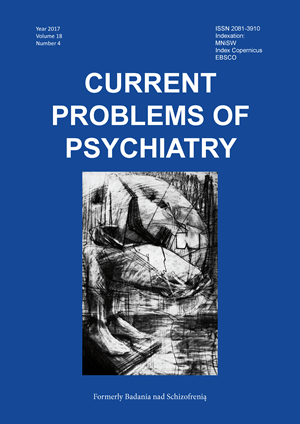Doświadczanie przemocy domowej w dzieciństwie a poziom osobowościowej cechy lęku u osób dorosłych
DOI:
https://doi.org/10.1515/cpp-2017-0030Słowa kluczowe:
lęk, przemoc domowa, dzieciAbstrakt
Cel. Celem pracy było poszukiwanie zależności między doświadczaniem różnych form krzywdzenia w dzieciństwie a nasileniem osobowościowej cechy lęku u ofiar przemocy domowej.
Materiał i metody. W badaniu wzięło udział 112 pacjentów (49 kobiet i 63 mężczyzn) Poradni Zdrowia Psychicznego na terenie województwa mazowieckiego. W badaniach wykorzystano ankietę socjodemograficzną oraz polską adaptację kwestionariusza STAI (C.D. Spielbergera).
Wyniki. Wysokie nasilenie cechy lęku częściej niż niskie wiąże się z doświadczaniem przemocy (fizycznej i psychicznej) w dzieciństwie, najczęściej przemoc przybiera formy opresji psychicznej, której sprawcą jest ojciec (p<0.01). Osoby z wysokim poziomem cechy lęku znacząco liczniej nadal doświadczają przemocy, mieszkają ze sprawcami przemocy oraz stosują przemoc wobec innych (p<0.05).
Wnioski. Świadomość psychologicznych konsekwencji stosowania przemocy wobec najmłodszych, pozwala mieć nadzieję na optymalizację działań zapobiegających rozpowszechnianiu patologii (m.in. terapeutyczną pracę z wyuczoną bezradnością oraz powielaniem destrukcyjnych wzorców rodzinnych).
Bibliografia
1. KGP http://www.statystyka.policja.pl/portal/st/944/50863/ Przemoc_w_rodzinie.html. 2011.
2. Wójcik, Sz. Przemoc fizyczna wobec dzieci. Dziecko Krzywdzone, 2012; 2(39): 7-28.
3. Kempe, H.R., Kempe, C.H.: Assessing Family Pathology. W: Helfer R.E., Kempe R. red., Child Abuse and Neglect. The Family and Community. Cambridge; Mass Ballinger: 1976. s. 136-138.
4. Przetacznik-Gierowska, M., Tyszkowa, M. Psychologia rozwoju człowieka, T. 1. Warszawa; Wydawnictwo Naukowe PWN: 2000.
5. Brańka, Z. Przemoc w rodzinie wobec dziecka jako czynnik społeczno-pedagogicznego nieprzystosowania uczniów, T. 2. Kraków; Oficyna Wydawnicza „Text”: 2006.
6. Miller, A. Gdy runą mury milczenia. Warszawa; Media Rodzina: 2006.
7. Martin, S.L., Kilgallen, B., Dee, D.L., Dawson, S., Campbell, J. Women in a Prenatal Care/Substance Abuse Treatment Program: Links Between Domestic Violence and Mental Health. Maternal and Child Health Journal, 1998; 2(2): 85-94.
8. Oatley, K., Jenkins, J.M. Zrozumieć emocje. Warszawa; Wydawnictwo Naukowe PWN: 2005.
9. Jouriles, E.N., Brown, A.S., McDonald, R., Rosenfield, D., Leahy, M.M., Silver, Ch. Intimate Partner Violence and Preschoolers’ Explicit Memory Functioning. Journal of Family Psychology, 2008; 22(3): 420-428.
10. Spielberger, C.D., Strelau J., Tysarczyk, M. i Wrześniewski, K. Inwentarz Stanu i Cechy Lęku STAI. Warszawa; Wyd. PTP: 1987.
11. Kendall, P.C. Zaburzenia okresu dzieciństwa i adolescencji. Gdańsk; Gdańskie Wydawnictwo Psychologiczne: 2004.
12. Bandura, A., Walters, R.H. Agresja w okresie dorastania (przekład z j. ang. Cz. Czapow). Warszawa; PWN: 1968.
13. Eron, L.D. Parent-Child Interaction, Television Violence, and Aggression of Children. American Psychologist, 1987; 37(2): 197-211.
14. Bandura, A. Psychological mechanisms of aggression [w:] Geen, R.G., Donnerstein, E.I. (red.). Aggression: Theoretical and Empirical Reviews, T.1. New York; Academic Press: 1983, s. 1-40.
Pobrania
Opublikowane
Numer
Dział
Licencja
Prawa autorskie (c) 2017 Autorzy

Praca jest udostępniana na licencji Creative Commons Attribution-NonCommercial-NoDerivatives 3.0 Unported License.


